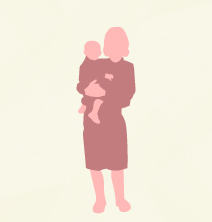Non-hereditary familial cancer
A substantial number of familial cancers are not hereditary.
In these cases there is no hereditary mutation behind the disease presence in a family.
The genetic susceptibility is instead associated with multiple genes, each with a negligible effect on the risk of cancer but that when together increase the individuals’ susceptibility to certain environmental factors.
In this case the cancer is said to result from shared genetic and environment.
An example would be:
- A family with light skin and light eyes, highly sensitive to the sun radiation (shared genetics), with a habit of overexposure to the sun without protection (shared lifestyle/environment).
Shared environment + genetic in a family

In non-hereditary familial cancer the risk of developing the disease within the family is higher than in the general population, but:
- The increased risk of disease does not pass from parents to children;
- The genetic factors contributing to cancer susceptibility can not be detected with a genetic test;
- As in sporadic cancer, the disease tends to develop later in life, at 60-70 years of age.
Learn also about:
> Hereditary familial cancer



